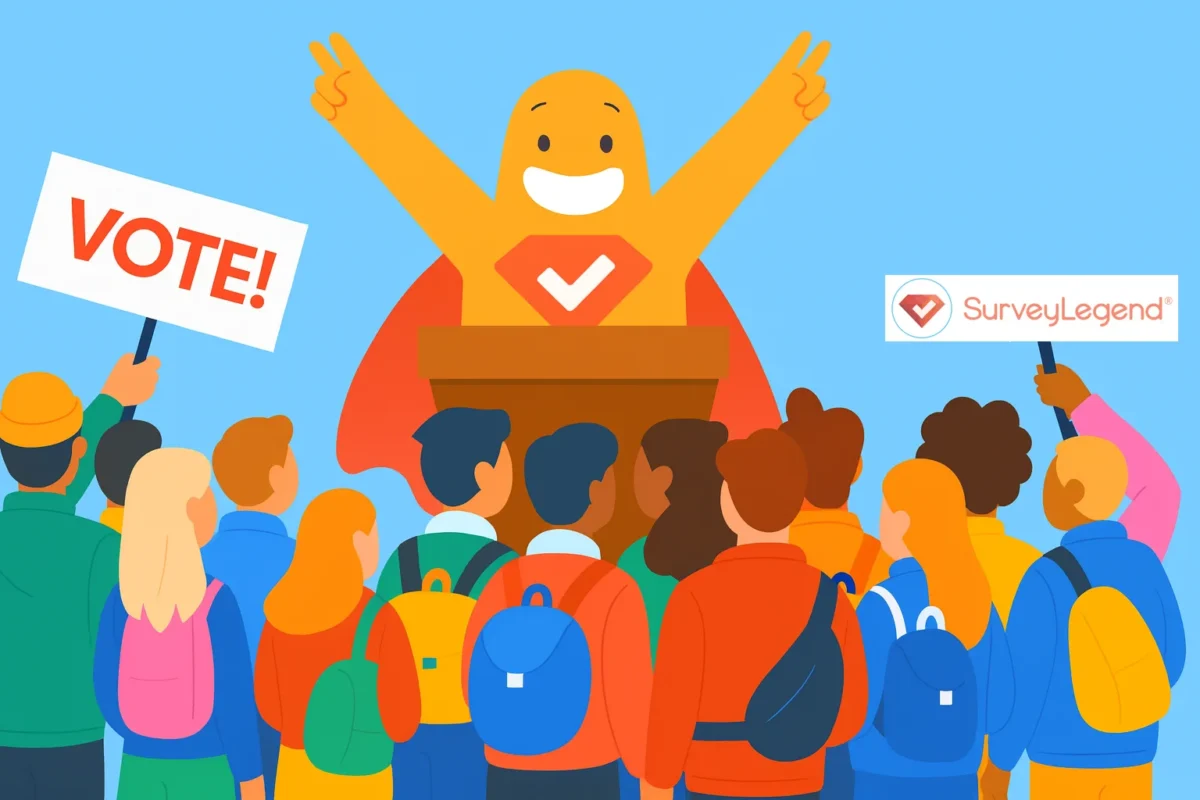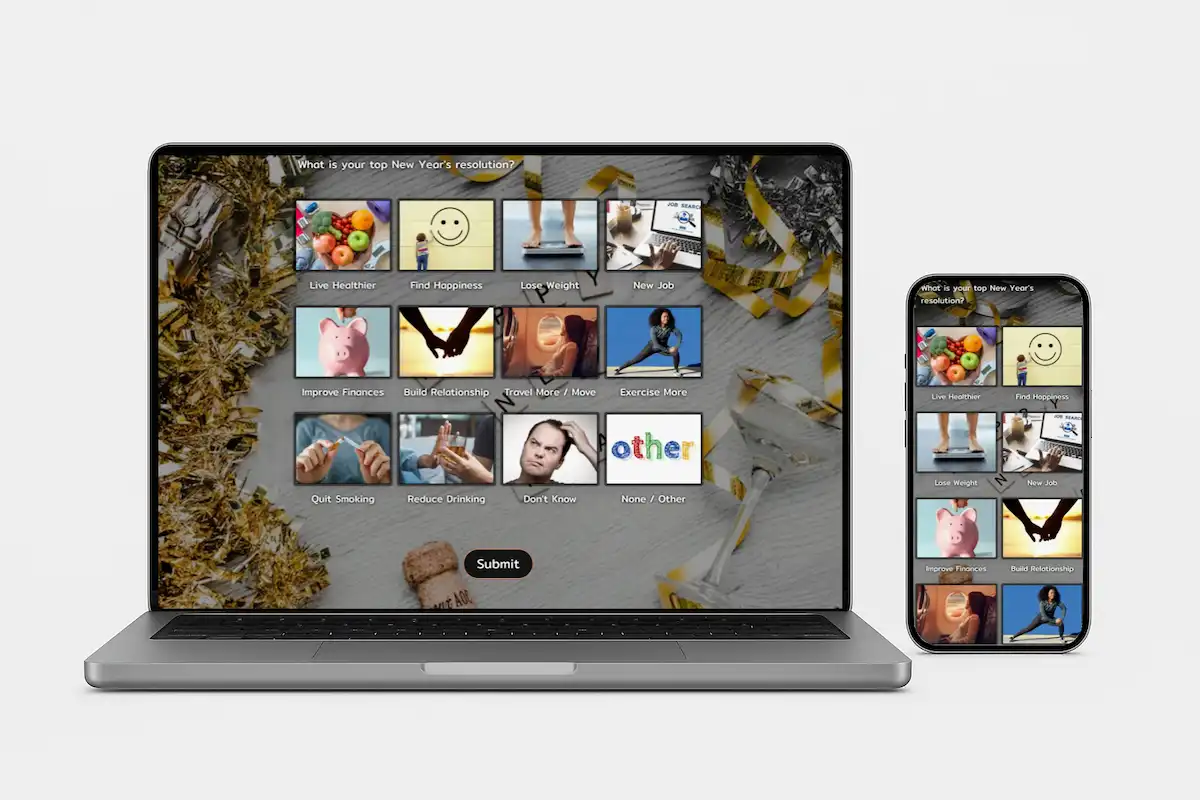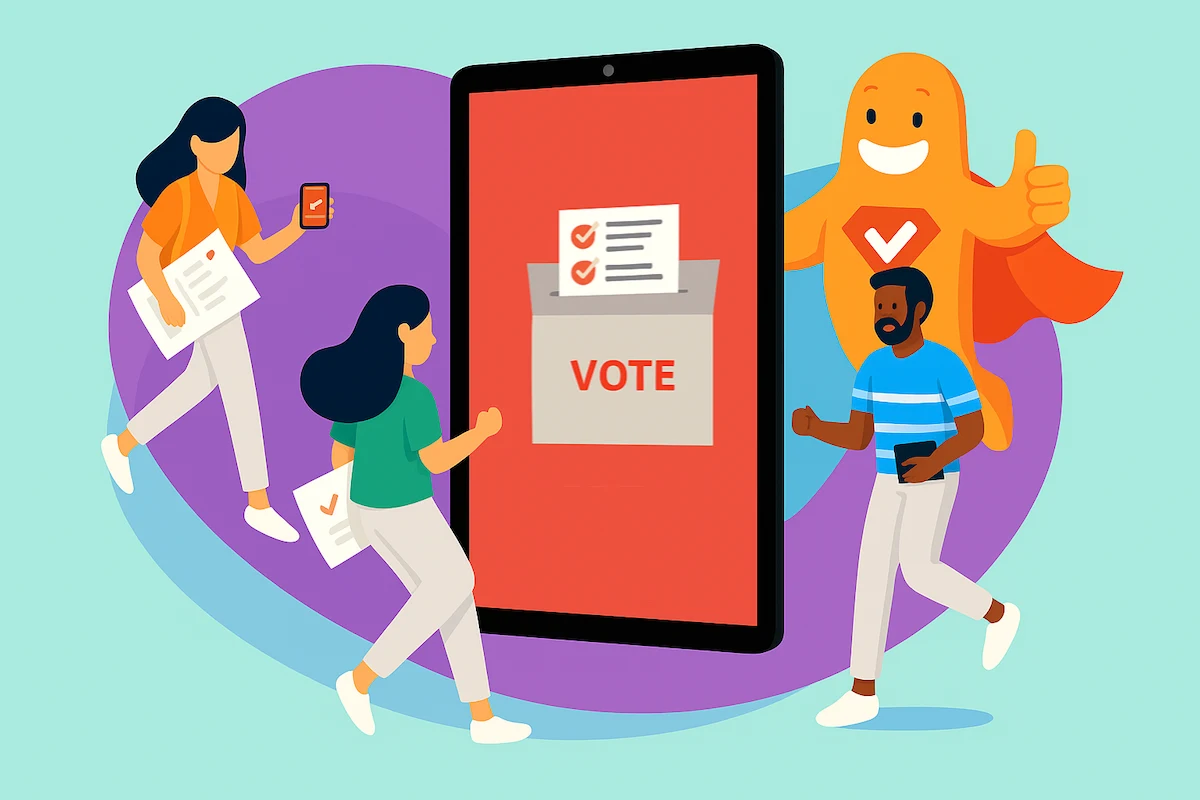Political surveys are essential tools for understanding voter behavior, public opinion, and political trends, but their accuracy depends on sound methodology. To ensure reliable results, researchers must use representative samples that reflect diverse demographics, apply random or stratified sampling, and avoid bias in question design. Surveys should offer balanced response options, ensure anonymity to promote honesty, and be conducted at well-timed intervals to capture genuine sentiment. Data analysis should account for margins of error, demographic differences, and external events. By following these best practices and maintaining transparency, pollsters can produce credible insights that inform campaigns, policymakers, and the public while upholding trust in democratic processes.
Create Your Political Survey Or Poll Now For FREE!
Understanding Political Surveys & Polls
A political survey is a method of gathering public opinion on political issues, candidates, policies, or elections by asking a series of questions. A political poll, on the other hand, generally only asks one question (or just a handful of questions, similar to a microsurvey). Both political surveys and polls are generally conducted by polling organizations, political parties, researchers, or media outlets to understand voter behavior, political preferences, and societal trends. Political surveys also seek to understand the underlying beliefs that shape respondents’ attitudes toward political and social issues.
Political Survey Types
Political surveys can be broken down into five categories, as follows.
- Pre-election polls measure voter preferences before an election and are used to project the vote count or analyze voting trends.
- Exit polls which are conducted outside polling stations to predict election outcomes by measuring the actual vote as reported by voters.
- Public opinion polls are used at any time to assess views on government performance, policies, or politicians. These can sometimes be called a “Mood of the Nation” survey, which we’ve written all about here!
- Issue-based surveys which focus on specific topics like healthcare, economy, or immigration.
- Approval rating polls are used to gauge public support for politicians or political institutions.
Methods of Conducting Political Surveys
A political survey questionnaire can be conducted in a variety of ways, with those using today’s technologies quickly becoming the preferred method of collecting responses.
- Online Polls. These are typically conducted via email, but other forms of online surveys have become popular, including
social media surveys,
embedded surveys on a website, and
pop-up surveys, which can grab someone’s attention while they’re perusing the internet. - Face-to-Face Surveys. These could be planned or scheduled one-on-one interviews, intercept surveys, or “man on the spot” surveys in which interviewees randomly choose respondents at certain locations or events, or focus groups in which a group is gathered to discuss politics with a moderator leading the discussion.
- Mail-in Questionnaires. Despite the ease of email surveys, mail-in surveys may still be used because they are delivered to a physical home address, making them feel more personalized or often garnering high response rates because of this. It is also a good way to reach seniors who may not be active with email or using a mobile device.
- Phone Surveys. This involves randomly placed calls, or targeted calls, to landlines or mobile phones. These can be conducted by a live interviewer or through IVR (interactive voice response) in which pre-recorded questions are asked and respondents answer using their keypad.
- Text Surveys. These are also conducted via phone, but can only be done through mobile devices. The survey is delivered via text message if someone has opted in. Many political polls are conducted this way as they generally focus on one question only.
Many political surveys are conducted over the span of a week or two to ensure the data collected is both timely and relevant to current events.
Other types of political survey methods are not used as frequently but can still be effective. Read about all
18 types of survey methods here.
Create Your Political Survey Or Poll Now For FREE!
5 Reasons Political Surveys Are Surging
Politics, which used to be on the QT for many people, is now a topic on the tip of everyone’s tongue – and there are some deep political divides. Organizations and the media alike may seek to understand how and why various groups of people can feel so differently, making political polling more popular than ever. Some other reasons for this surge in political surveying?
- Identifying Trends. Political news is now 24/7, and things can change in an instant. Regular polling helps track shifts in political views over time.
- Tracking Societal Values and Cultural Attitudes. Political surveys are used to monitor changes in societal values, beliefs, and cultural attitudes, helping researchers understand how these principles evolve across different groups and countries.
- Predicting Election Outcomes. Political surveys provide an estimate of which candidate or party is likely to win. This can influence media coverage and public opinion. Be sure to read our blog
How To Make Election Predictions With Political Surveys. - Utilizing New Technology. The variety of online survey options and the development of
AI surveys make it easier and cheaper to conduct frequent polls to gauge voter sentiment. Plus, social media enables pollsters to put out feelers in an instant and reach thousands when they do with real-time results. - Informing Advocacy And Academic Research. Political surveys can help interest groups and activists understand the views of the public on specific causes. The results might be used to build support for or against a policy, law, or candidate. Additionally, academics use political surveys to analyze political behavior, voting patterns, and other socio-political phenomena. These surveys contribute to the field of political science and broader social research.
- Guiding Campaign Strategy. Politicians and parties used to make decisions more or less in the dark; today, they can use aggressive real-time polling to shape effective campaign platforms, develop or refine messaging, target specific voter groups, and inform outreach efforts.
While more polls are being conducted, their accuracy varies depending on methodology, sample size, and biases.
Political Polling Pitfalls
Political polls and surveys can come with a whole host of problems when not conducted correctly, or results are not considered within certain contexts. The most famous political survey failure occurred in 1948. At the time, Harry Truman and Thomas Dewey were battling it out for the United States Presidency. To predict the winner, a nationwide telephone survey was conducted, and the results heavily favored Dewey. The Chicago Daily Tribune, confident in the survey and wanting to be the first to break the news, printed its newspaper with the headline
“Dewey Defeats Truman”.
Of course, Dewey didn’t win, leaving the paper with egg on its face and resulting in this famous photo of winner Truman holding up the paper with the incorrect headline.

What went wrong? In 1948, only wealthy families owned telephones, and those with money tended to favor Dewey. Those who couldn’t afford a phone mostly backed Truman, but they were completely left out of the survey due to the phone sampling bias. When key polling data is lost or not collected, as seen in later administrations, campaigns can face significant strategic disadvantages.
With this in mind, here are seven political polling pitfalls to watch out for.
- Accuracy Issues: As in the example above, polling results can sometimes be inaccurate due to sampling errors. Another example would be online polls not representing older demographics well (hence the need to supplement them with mail-in surveys).
- Over or Under-Representing Certain Groups: This goes hand-in-hand with number one above. If polls don’t properly account for the demographic distribution of voters (e.g., rural vs. urban, different age groups, and education levels), it can lead to inaccurate predictions.
- Non-Response Bias. People who choose not to participate in surveys might have different opinions than those who do, leading to skewed results.
- Overemphasis on Numbers: Poll results can be overemphasized in media and campaigns, shaping public perception before an election or influencing voter behavior in ways that may not align with actual election outcomes.
- Projection Limitations: Overreliance on poll projection models can be risky, as projections may not always accurately forecast election outcomes due to unforeseen events or methodological issues.
- Manipulation: Polls can be skewed by the organizations conducting them, depending on how questions are worded or which groups they target. This can lead to misleading results or the creation of false narratives.
- Short- And Long-Term Focus: Political polls often focus on momentary shifts in opinion rather than long-term trends, which can lead to policy decisions that reflect short-lived public moods instead of lasting societal needs. On the other hand, surveys focused on long-term views can be inaccurate as voters’ opinions can change late in the election cycle, making it hard to predict outcomes accurately in the final days.
- Encouraging Polarization: Constant polling can sometimes reinforce divisions between political groups by emphasizing differences rather than finding common ground.
Why People Lie On Political Surveys
A pitfall that is hard to overcome is that
some people will lie on political surveys.
Although many people taking political surveys genuinely want to express their opinions and feel a sense of responsibility to be truthful, especially if the survey is anonymous, others may not be so honest. These factors can lead to some discrepancies between how people answer a political survey question and what they actually believe or do in real life. This is why survey results often have margins of error or why pollsters must use careful methodology, including techniques to reduce bias (e.g., random sampling, question design, and ensuring anonymity).
Why do they lie?
- Social Desirability Bias. Many people may provide responses that they believe are socially acceptable or align with the “right” answer, even if it’s not their true opinion. For example, they might say they support a popular candidate or issue because it’s seen as the socially acceptable stance, even if they privately disagree.
- Fear of Judgment. In some political climates, people may fear judgment for holding certain views. They might lie to avoid confrontation or backlash, especially if their opinions are seen as unpopular or controversial in their community.
- Accidental Inaccuracies. Participants might misremember or misunderstand their own opinions, leading them to give answers that aren’t fully aligned with their true thoughts.
- Strategic Lying:
Some people might intentionally mislead surveyors to influence the outcome of the poll, especially if they believe their responses could impact a political cause they care about. This is less common but does happen in certain circumstances. - Protest Responses:
Some respondents might give answers that are intentionally false to make a statement or protest a political system or a particular party. This can happen when they feel disillusioned with the options available to them.
Create Your Political Survey Or Poll Now For FREE!
Data Quality Control in Political Surveys
Ensuring data quality is at the heart of trustworthy political surveys. Leading organizations in public opinion research, such as the Pew Research Center, set the standard for rigorous polling operations by implementing strict quality control measures. Polling firms use a variety of techniques to guarantee that the data collected from respondents is both accurate and reliable. This includes employing random sampling to avoid selection bias, applying statistical weighting to reflect the true makeup of the population, and validating respondent information to prevent duplicate or fraudulent responses.
During high-stakes events like the presidential election, pollsters often turn to advanced statistical models to correct for potential biases and improve the accuracy of their projections. Internal polling conducted by campaigns and political parties also follows these best practices, as reliable insights are essential for candidates and strategists to make informed decisions. By prioritizing data quality control throughout every stage of the survey—from design to data analysis—polling organizations can deliver credible results that inform voters, politicians, and the media. Ultimately, robust data quality control strengthens the value of public opinion research and supports the integrity of the democratic process.
Ensuring The Most Accurate Political Surveys
To get the most accurate results in a political survey, several best practices should be followed in the survey design, data collection, and analysis processes.
It is also crucial to choose reputable polling services, as these services provide the expertise and institutional support necessary to ensure the accuracy and reliability of political survey results.
1. Ensure a Representative Sample
- Random Sampling: Use random sampling techniques to ensure that the sample reflects the diversity of the population being studied, including the inclusion of independent respondents or employing independent sampling methods to avoid bias. This includes a mix of different demographics such as age, race, gender, income, education level, and geographic location. Read more about random sampling.
- Stratified Sampling: This method divides the population into subgroups (strata) based on specific characteristics (e.g., political party affiliation, age groups, etc.) and then samples from each subgroup. It ensures all relevant groups are properly represented.
- Large Sample Size: Larger sample sizes reduce the margin of error, making the survey more reliable. While small samples may be quicker and cheaper, they can lead to less accurate results.
2. Use Multiple Data Collection Methods, Account For Non-Response
- Multiple Methods: If possible and the budget allows for it, use a variety of data collection techniques. Choose several from the options we highlighted earlier. For example, conduct your survey using email surveys, telephone surveys, and mail-in surveys. This will assure representation from different groups and help avoid another Truman/Dewey debacle!
- Non-Response Follow-Up: If a significant portion of your sample doesn’t respond, follow up with reminders or offer survey incentives to boost response rates. This reduces non-response bias, which occurs when certain groups (e.g., younger voters or those in spec
3. Design Neutral and Clear Questions
- Avoid Leading Questions: Questions should be neutral and not suggest a particular answer. For example, instead of asking, “Don’t you think government spending is too high?” ask, “What is your opinion on government spending?” Read our blog 5 Types of Leading Questions With Examples for more.
- Use Simple and Clear Language: Avoid jargon or overly complex questions. Clear, simple language helps respondents understand the question without confusion.
- Offer Balanced Response Options: Ensure that response options cover the full range of possible opinions and that there’s a middle or neutral option when applicable. For example, using “Strongly Agree, Agree, Neutral, Disagree, Strongly Disagree” for Likert scale questions.
4. Adjust for Demographic and Political Differences
- Political Affiliation: Make sure your sample includes people from different political backgrounds, including republican respondents, as well as Democrats, Independents, etc., to avoid skewing results toward a particular ideology.
- Geographic Location: Include respondents from various geographic areas (urban, rural, suburban) to ensure the survey reflects national diversity, especially in politically divided regions.
- Age and Income Groups: Account for generational differences, as younger voters and older voters may have different political priorities or voting habits.
5. Ensure Anonymity and Privacy
- Confidentiality: Assure respondents that their answers are confidential. When people feel their responses won’t be judged, they are more likely to answer truthfully, particularly on sensitive issues.
- Anonymous Responses: Anonymity reduces social desirability bias, where people may lie about their opinions to conform to social expectations.
6. Use a Well-Timed Survey
- Avoid Timing Bias: Political opinions can shift rapidly. Timing your survey before or after a significant event, such as a debate, scandal, or policy announcement, can impact responses. Conducting political surveys early in a campaign provides timely insights and helps inform strategic decisions before major shifts occur.
- Track Opinion Changes: To get more accurate long-term data, track changes over time, and conduct repeated surveys at regular intervals to identify trends in political sentiment.
7. Analyze Data Carefully
- Account for Error Margins: Every survey comes with a margin of error. Understanding and factoring in these margins helps interpret results accurately.
- Examine Cross-Tabulations: Break down the data by different groups (e.g., age, political affiliation, geography) to get deeper insights. It helps to understand how different segments of the population feel about an issue.
- Consider External Factors: Recognize that external events, media coverage, or unexpected events can influence survey results, especially close to election times.
- Focus on Trends, Not Just One-Time Results: To understand true public opinion, focus on long-term trends rather than relying on one-off survey results, which can be swayed by temporary factors.
By following these best practices, you can improve the accuracy and reliability of your political survey or political poll, making sure the results are a true reflection of public opinion.
Create Your Political Survey Or Poll Now For FREE!
Evaluating Polling Results
Interpreting the results of political polls requires more than just glancing at the headlines. To truly understand what recent polls reveal about public opinion, it’s essential to examine the methodology used, the size and diversity of the sample, and the reported margin of error. Polling firms, especially those working with major media outlets like CNN, are expected to be transparent about how their polls are conducted and how data is collected.
When analyzing polling results, it’s wise to look at the average of multiple polls conducted by reputable organizations. In most cases, a majority of well-conducted surveys will point to similar trends, providing a clearer picture of the political landscape. For example, during the 2020 presidential election, the average of polls from respected polling firms closely matched the final outcome, demonstrating the value of aggregating data. Always consider the context—such as recent events or shifts in public sentiment—that might influence results. By carefully evaluating polling data, voters, politicians, and the media can make more informed decisions and gain deeper insights into the direction of the nation.
Common Challenges in Polling
Modern polling operations face a host of challenges that can impact the accuracy and reliability of public opinion research. One of the most pressing issues is declining response rates, as fewer adults are willing to participate in surveys, whether online or by phone. This makes it harder for polling firms to gather representative samples, especially in countries with diverse populations and varying levels of internet access.
Reaching certain groups—such as young adults, minority communities, or rural residents—can be particularly difficult, leading to potential biases in the results. The rise of online surveys has helped expand access, but it also introduces new challenges, such as ensuring data security and verifying respondent authenticity. Additionally, the spread of misinformation and fake news can influence public opinion and, in turn, the outcomes of polls.
To address these challenges, pollsters and organizations are investing in innovative methodologies, including advanced data analytics and machine learning, to improve the accuracy of their insights. By acknowledging these obstacles and adapting their approaches, polling firms can continue to provide valuable support for democratic decision-making and help ensure that the voices of all groups are heard.
Future of Political Polling
The future of political polling is being shaped by rapid technological advancements and shifts in how voters engage with politics. As the internet and social media become increasingly central to political campaigns and public discourse, polling firms are developing new ways to collect and analyze data. Online surveys and social media analytics now offer real-time insights into voter preferences and behavior, allowing pollsters to track trends as they emerge.
Artificial intelligence and machine learning are also transforming the field, enabling pollsters to sift through vast amounts of data to identify patterns and make more accurate projections. For example, Joe Biden’s 2020 presidential campaign leveraged sophisticated data analytics and polling to inform their strategy and connect with voters across the country. As campaigns and organizations become more data-driven, the demand for transparent, innovative, and methodologically sound polling will only grow.
To remain relevant and effective, polling organizations must continue to embrace new technologies, prioritize transparency, and uphold rigorous standards. By doing so, they will provide essential insights for voters, candidates, and the media, supporting the health and vibrancy of democracy in the digital age.
Political Survey Example
Here’s a look at a political survey created using SurveyLegend’s free online political survey tool. Creating a political survey can be approached as a project, with defined objectives, a clear methodology, and desired outcomes. As you can see, many types of political survey questions can be asked (photo-related, multiple choice, scales, and so on). The survey is also branded at the top to lend credibility and improve response rates.

Conclusion
Political polls and surveys are valuable tools for understanding public opinion. But remember that their reliability depends on how you conduct them, interpret the data, and apply your learnings. Thankfully, SurveyLegend makes all of this easy. Our surveys and polls are easy to create and easy on the eyes, so respondents are more apt to engage with them. We offer a variety of question types, and the platform supplies robust analysis during or at the conclusion of a survey, making reporting less of a chore and giving you more time to plan your next survey! Additionally, the platform enables users to generate a detailed report summarizing the findings of their political survey, providing an authoritative and comprehensive resource for election and political trend insights.
Create Your Political Survey Or Poll Now For FREE!
Frequently Asked Questions (FAQs)
What is the main difference between a political poll and a political survey?
A political poll typically measures public opinion on a specific issue or candidate at a given time, while a political survey collects more in-depth data on attitudes, behaviors, and trends over time.
How can political survey questions be misleading?
Polls can be misleading due to biased questions, small or unrepresentative samples, and how the results are framed or interpreted.
Why are political surveys important?
They help politicians, researchers, and policymakers understand public opinion, predict election outcomes, and develop strategies based on data-driven insights.
What is a pollster?
A pollster is a person or organization responsible for designing, conducting, and analyzing political surveys and polls. Pollsters play a key role in advising candidates, shaping campaign strategies, and providing insights that influence political decision-making.



